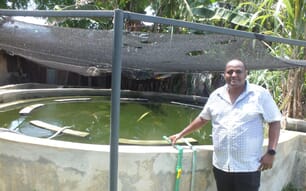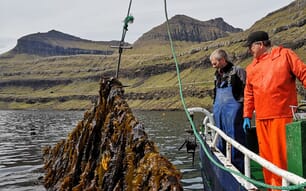
© SIU
Scientists at SIU’s Center for Fisheries, Aquaculture, and Aquatic Sciences came up with the idea to grow coral about a decade ago, just as construction was beginning on the initial phase of the Saluki Aquarium, which currently houses about 10,000 gallons of research and display tanks. Officials hope to expand the facility, including a planned 9,000-gallon marine display and teaching aquarium.
Current active freshwater and marine research at Saluki Aquarium includes finding unique ways to identify the ages of walleyes, chemical signatures of movement in crayfish, toxicology of Chinook salmon and culturing Atlantic silversides.
“SIU has research and teaching strengths in both freshwater and marine science,” Jim Garvey, director of the centre, said in a press release. “The Saluki Aquarium is there to explore the connections between the two disciplines, of which the new coral farm is a centerpiece.”
With its location near the confluence of the Mississippi and Ohio rivers – two major waterways with huge impacts on the Gulf of Mexico ecosystem – SIU says that the Saluki Aquarium provides the perfect research environment to explore complex linkages between freshwater and marine ecosystems. Southern Illinois itself, located far from ocean water, nevertheless plays an important role in its health.
“Water use in our farms and cities has direct impacts on marine life – including corals – downstream,” Garvey said.
Aquacultural implications
Corals are endangered globally. But what may also be surprising to many people is that there is an enormous aquarium trade in ornamental corals around the world, Garvey said.
“Only a fraction of corals is farmed, with the remainder harvested from reefs,” he said. “We built the coral farm in the Saluki Aquarium to test both basic and applied questions about coral growth and survival to improve coral aquaculture and reduce pressure on wild reefs.”
Ashlynn Shea, a junior in zoology from Kansas, is the coral farm’s primary caretaker, as well as the lead person on increasing student engagement in the project. She also conducts research related to the effort.
“I am working on looking at coral health implications with varying flow rates by observing morphological features and observing microbial colonies that make up the corals’ gut,” Shea said. “These microbes help feed the corals to survive and thrive in an ecosystem.”
Shea said the work is providing her with hands-on experience with corals.
“Taking care of any living organism, especially in an aquaculture facility, is difficult, but it’s extremely more difficult and challenging with corals as they don’t exhibit the same behaviours fish exhibit,” Shea said. “Water quality is an extremely important aspect in any system, but even more in the saltwater coral systems. The water quality will dictate their survival, and if one thing changes overnight, it could result in disease and possibly death. Monitoring water quality is a highly important daily task.”
Garvey said the coral farm is unique in allowing students hands-on opportunities to conduct research while learning about maintaining indoor marine aquatic recirculating systems.
“Corals have very specific water quality and lighting needs, so experience with this system will prepare them for jobs in public aquariums like the Shedd Aquarium in Chicago or aquaculture facilities on the coasts,” he said.




